Related Research Articles

The Silurian is a geologic period and system spanning 24.6 million years from the end of the Ordovician Period, at 443.8 million years ago (Mya), to the beginning of the Devonian Period, 419.2 Mya. The Silurian is the third and shortest period of the Paleozoic Era, and the third of twelve periods of the Phanerozoic Eon. As with other geologic periods, the rock beds that define the period's start and end are well identified, but the exact dates are uncertain by a few million years. The base of the Silurian is set at a series of major Ordovician–Silurian extinction events when up to 60% of marine genera were wiped out.

Millipedes are a group of arthropods that are characterised by having two pairs of jointed legs on most body segments; they are known scientifically as the class Diplopoda, the name derived from this feature. Each double-legged segment is a result of two single segments fused together. Most millipedes have very elongated cylindrical or flattened bodies with more than 20 segments, while pill millipedes are shorter and can roll into a tight ball. Although the name "millipede" derives from Latin for "thousand feet", no species was known to have 1,000 or more until the discovery in 2020 of Eumillipes persephone, which can have over 1,300 legs. There are approximately 12,000 named species classified into 16 orders and around 140 families, making Diplopoda the largest class of myriapods, an arthropod group which also includes centipedes and other multi-legged creatures.
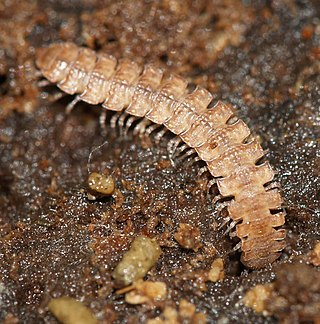
Chilognatha is a subclass of the class Diplopoda, which includes the vast majority of extant millipedes, about 12,000 species.
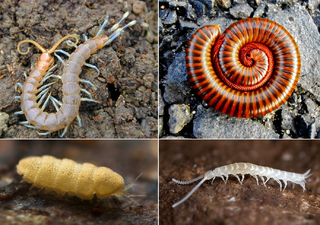
Myriapods are the members of subphylum Myriapoda, containing arthropods such as millipedes and centipedes. The group contains about 13,000 species, all of them terrestrial.

Arthropleuridea is an extinct subclass of myriapod arthropods that flourished during the Carboniferous period, having first arisen during the Silurian, and perishing in the Early Permian. Members are characterized by possessing diplosegement paranotal tergal lobes separated from the body axis by a suture, and by sclerotized plates buttressing the leg insertions. Despite their unique features, recent phylogenetic research suggests Arthropleuridea be included among millipedes in the class Diplopoda. The subclass contains three or two recognized orders, each with a single genus.

Pill millipedes are any members of two living orders of millipedes, often grouped together into a single superorder, Oniscomorpha. The name Oniscomorpha refers to the millipedes' resemblance to certain woodlice (Oniscidea), also called pillbugs or "roly-polies". However, millipedes and woodlice are not closely related ; rather, this is a case of convergent evolution.
Euphoberia is an extinct genus of millipede from the Pennsylvanian epoch of the Late Carboniferous, measuring up to 15 centimetres (5.9 in) in length, that is small in Euphoberiidae which contains species with length about 30 centimetres (12 in). Fossils have been found in Europe and North America.

Pneumodesmus newmani is a species of myriapod. It is originally considered that it lived during the late Wenlock epoch of the Silurian period around 428 million years ago. However, a 2017 study dates its occurrence based on zircon data analysis as the Early Devonian (Lochkovian). Although the 2023 study confirmed the age identification of the 2004 study through palynological, palaeobotanical and zircon analyses incorporating newly discovered additional data, this is based on adjacent structurally separated block with different stratigraphy and sedimentology to the block with fossil site it was discovered, and it is confirmed as unsustainable. It is one of the first myriapods, and among the oldest creatures to have lived on land. It was discovered in 2004, and is known from a single specimen from Stonehaven, Aberdeenshire, Scotland.

Glomerida is an order of pill-millipedes found primarily in the Northern Hemisphere. Also known as northern pill millipedes, they superficially resemble pill-bugs or woodlice, and can enroll into a protective ball. They have twelve body segments, 17 to 19 pairs of legs, and males have enlarged rear legs involved in mating. The order includes about 30 genera and at least 280 species, including Glomeris marginata, the common European pill-millipede. The order contains members in Europe, South-east Asia and the Americas from California to Guatemala. Although historically considered closely related with the similar sphaerotheriidans that also enroll, some DNA evidence suggest they may be more closely related to glomeridesmidans, a poorly known order that does not enroll.
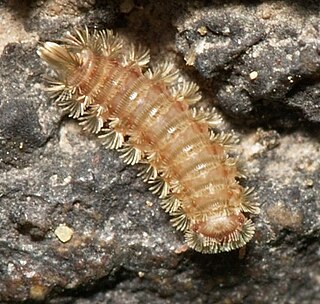
Polyxenida is an order of millipedes readily distinguished by a unique body plan consisting of a soft, non-calcified body ornamented with tufts of bristles. These features have inspired the common names bristly millipedes or pincushion millipedes. This order includes about 148 species in four families worldwide, which represent the only living members of the subclass Penicillata.

Archipolypoda is an extinct group of millipedes known from fossils in Europe and North America and containing the earliest known land animals. The Archipolypoda was erected by Scudder (1882) but redefined in 2005 with the description of several new species from Scotland. Distinguishing characteristics include relatively large eyes with densely packed ocelli, and modified leg pairs on the 8th body ring. Some species had prominent spines while others had a flattened appearance.

Zosterogrammidae is an extinct family of millipedes containing three genera, each with a single species. Fossils are known from the Czech Republic, Scotland, and the USA. Zosterogrammidae constitutes the sole family of the order Zosterogrammida.
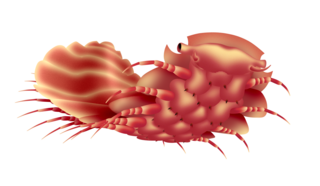
Microdecemplex rolfei is the only known species of the extinct, small-bodied millipede order Microdecemplicida. This order is originally considered as a member of the extinct subclass Arthropleuridea, but study in 2024 suggested to reject from the group, instead belongs to subclass Chilognatha. Fossils, measuring less than 5 mm in length, are known from the Panther Mountain Formation of New York State, dating to the Middle Devonian. This species apparently lacks antennae and shows sexual dimorphism in its hind legs, which may be similar in function to the telopods of male living pill-millipedes that are used to grasp females during mating.

Euphoberiidae is an extinct family of archipolypodan millipedes known from the Upper Pennsylvanian of Europe and North America. The family includes relatively large millipedes measuring up to 30 cm (12 in) long bearing distinctive spines and were the dominant millipedes of the Pennsylvanian.
Cowiedesmus is an extinct millipede genus described from Scotland, and is considered as earliest known land animals alongside Pneumodesmus from same formation. It is originally considered that it is from the middle Silurian, a 2017 study suggested that the geological formation it contains actually appears to be from the Early Devonian (Lochkovian) instead. Although a 2023 study confirmed the age identification of the 2004 study through palynological, palaeobotanical and ziron analyses incorporating newly discovered additional data, this is based on adjacent structurally separated block with different stratigraphy and sedimentology to the block with fossil site it was discovered, and it is confirmed as unsustainable. Cowiedesmus was about 4 cm (1.6 in) long and characterized by a greatly enlarged pair of legs on the 8th segment which may have been used in clasping females or functioned as gonopods. Coweiedesmus is distinct enough from other living and fossil millipedes to be placed in its own order, Cowiedesmida. The only known species, C. eroticopodus, was described in 2004.

Archidesmus is an extinct millipede genus from the Lower Devonian Old Red Sandstone of the United Kingdom. It is the only member of the taxonomic family Archidesmidae. Individuals were up to 5 cm (2.0 in) long, and had 60 to 80 body segments decorated with tubercles (bumps) on the upper surface, and most segments possessed wing-like keels (paranota) extending to the side. The type species Archidesmus macnicoli was described by British paleontologist Benjamin Peach in 1882. A second species, A. loganensis was also described by Peach but its status as a valid species- or even a myriapod- is debated.

Palaeosoma is an extinct genus of archipolypodan millipedes from the upper Carboniferous of England and Poland. Individuals grew to nearly 20 cm (7.9 in) long and possessed defensive glands (ozopores) located on small raised nodes on the outer edges of the upper surface of each body segment. Species of Palaeosoma were once considered members of the family Euphoberiidae, which contains species with prominent spines, but are now classified in their own family (Paleosomatidae) and own order (Palaeosomatida), as they lack spines and have a combination of features not seen in other Paleozoic millipedes.

The Archidesmida is an extinct order of millipedes known from fossils from the Devonian period of Europe and North America. Archidesmidans have broad flat keels (paranota) extending from their body segments, and a modified pair of legs on the 8th segment that may have been involved in mating, similar to the gonopods of living millipedes which insert sperm into females. Alternately, the modified legs may have been used to grasp onto partners during mating.

The Cowie Formation is geological formation located on the Highland Boundary Fault between the fishing village of Cowie and Ruthery Head, in Aberdeenshire, Scotland. Age of this formation is controversial, that was originally estimated at the Middle Silurian, Wenlock to Ludlow, but zircon geochronology shows the Early Devonian, Lochkovian instead. In study published in 2023, according to spore microfossils and additional zircon data, the Middle Silurian, late Wenlock age is suggested again. However, in 2024 it is considered as unsustainable because this conclusion is based on adjacent structurally separated block with different stratigraphy and sedimentology to the block with fossil productive Fish Bed. This formation preserves fossils, including a millipedes such as Pneumodesmus and Cowiedesmus that were discovered by Mike Newman in 2001, and some agnathan like Cowielepis.
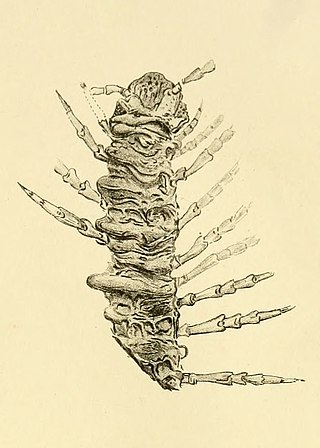
Kampecaris is an extinct genus comprising the Kampecarida, an enigmatic group of millipede-like arthropods, from the Silurian and early Devonian periods of Scotland and England. They are among the oldest known land-dwelling animals. They were small, short-bodied animals with three recognizable sections: an oval head divided along the midline, ten limb-bearing segments forming a cylindrical trunk that tapered slightly towards the front, and a characteristic swollen tail formed by a modified segment that tapers at its rear into an "anal segment". The cuticle forming their exoskeletons was thick, heavily calcified, and composed of two layers.
References
- ↑ Wilson, Heather M.; Anderson, Lyall I. (2004). "Morphology and taxonomy of Paleozoic millipedes (Diplopoda: Chilognatha: Archipolypoda) from Scotland". Journal of Paleontology. 78 (1): 169–184. Bibcode:2004JPal...78..169W. doi:10.1666/0022-3360(2004)078<0169:MATOPM>2.0.CO;2.
- ↑ Wilson, Heather M. (2005). "A new genus of Archipolypodan millipede from the Coseley Lagerstätte Upper Carboniferous, UK". Palaeontology. 48 (5): 1097–1100. Bibcode:2005Palgy..48.1097W. doi: 10.1111/j.1475-4983.2005.00496.x .